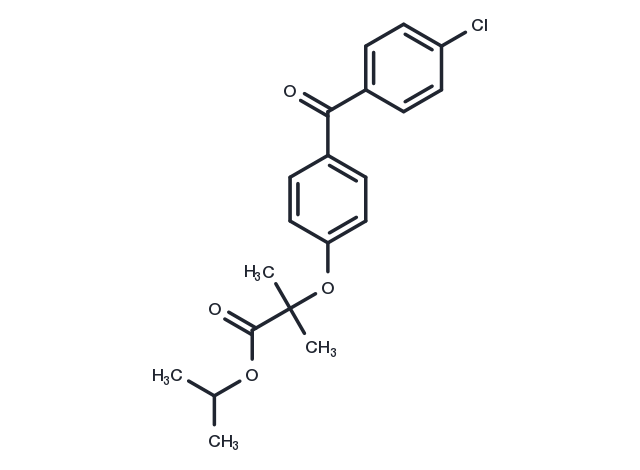Powder: -20°C for 3 years | In solvent: -80°C for 1 year


Fenofibrate (Lipanthyl) is a peroxisome proliferator receptor alpha agonist. Fenofibrate is a synthetic phenoxy-isobutyric acid derivate and prodrug with antihyperlipidemic activity.

| Pack Size | Availability | Price/USD | Quantity |
|---|---|---|---|
| 100 mg | In stock | $ 32.00 | |
| 200 mg | In stock | $ 45.00 |




| Description | Fenofibrate (Lipanthyl) is a peroxisome proliferator receptor alpha agonist. Fenofibrate is a synthetic phenoxy-isobutyric acid derivate and prodrug with antihyperlipidemic activity. |
| Targets&IC50 | PPARα:30 μM(EC50) |
| In vitro | Fenofibrate is a relatively potent inhibitor of CYP2B6 (IC50=0.7±0.2 μM) and CYP2C19 (IC50=0.2±0.1 μM). Fenofibrate is also a moderate inhibitor of CYP2C8 (IC50=4.8±1.7 μM) and CYP2C9 (IC50=9.7 μM)[1]. Fenofibrate binds to and inhibits cytochrome P450 epoxygenase (CYP)2C with higher affinity than to PPARα. Fenofibrate is a well-known PPARα agonist, but an in vitro assessment of 209 frequently prescribed drugs and related xenobiotics suggests that Fenofibrate is also a potent inhibitor of cytochrome P450 epoxygenase (CYP)2C. The affinity of Fenofibrate to CYP2C is >10 times higher (EC50=2.39±0.4 μM) than to PPARα (EC50=30 μM). Fenofibrate at a low dose inhibits CYP2C8 activity without PPARα activation[2]. |
| In vivo | Administering a low daily dose of Fenofibrate (10 μg/g/day) significantly reduces retinal and choroidal neovascularization, which is caused by CYP2C8 overexpression, by 29% (P=0.021) and 36% (P=1.2×10^-9) respectively[2]. |
| Kinase Assay | The half-maximal inhibitory concentrations (IC50s) of Fenofibrate, statins (atorvastatin, lovastatin, pravastatin, simvastatin and simvastatin acid, the active form of simvastatin) and glipizide for recombinant human CYP1A2, CYP2B6, CYP2C8, CYP2C9, CYP2C19, CYP2D6, and CYP3A4 are determined using fluorometric CYP450 inhibition assays. Briefly, the drugs are dissolved in methanol or acetonitrile. In 96 well assay plates, the drugs are diluted to a series of concentrations in a solution containing cofactors including NADP+ (final concentration 1.3 mM), MgCl2 (final concentration 3.3 m M), glucose-6-phosphate (G6P, final concentration 3.3 mM) and glucose 6-phosphate dehydrogenase (final concentration 0.4 U/mL). The mixture is pre-incubated at 37°C for 10 min. The enzymes and fluorogenic substrates are diluted to desired concentrations in sodium phosphate reaction buffer (pH 7.4, final concentration 200 mM) and mixed. Reactions are initiated with addition of the enzyme and substrate mixture to the cofactor and drug mixture. The final reaction volume of all assays is 200 μL. After incubating at 37°C for a pre-specified period of time (15 to 45 min), the reactions are stopped with addition of 75 μL quenching solution (0.5 M Tris base or 2N NaOH). Fluorescence is determined using a BioTek Synergy 2 fluorescence reader. Each of the drugs is tested at eight concentrations in duplicate. To estimate IC50s, percent of inhibition is calculated using net fluorescence that is corrected for the background. The values of percent of inhibition are then fitted to a three or four parameter log-logistic model[1]. |
| Synonyms | Procetofen, Lipanthyl, Lipantil |
| Molecular Weight | 360.83 |
| Formula | C20H21ClO4 |
| CAS No. | 49562-28-9 |
Powder: -20°C for 3 years | In solvent: -80°C for 1 year
Ethanol: 36.1 mg/mL (100 mM)
DMSO: 36.1 mg/mL (100 mM)
You can also refer to dose conversion for different animals. More
bottom
Please see Inhibitor Handling Instructions for more frequently ask questions. Topics include: how to prepare stock solutions, how to store products, and cautions on cell-based assays & animal experiments, etc.
Fenofibrate 49562-28-9 Autophagy DNA Damage/DNA Repair Metabolism PPAR P450 Procetofen inhibit Peroxisome proliferator-activated receptors Lipanthyl Lipantil CYPs Cytochrome P450 Inhibitor inhibitor
